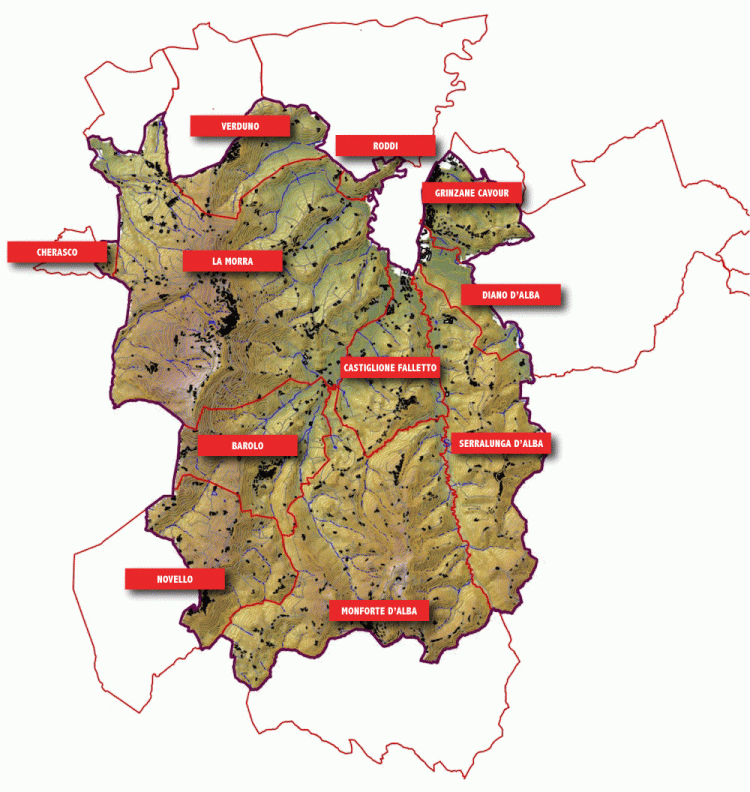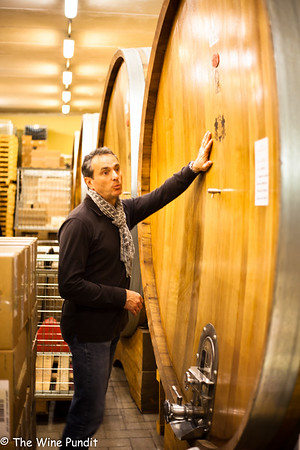Referring to the map he’s provided me with, Franco (a graduate of the oenologic school in Alba) gives a quick overview of the Barolo area – he mentions the eleven communes/villages (see below), and points out the Massolino Cru (i.e. single) vineyards, three of which are in Serralunga d’Alba proper, and one, Parussi, located in Castiglione Falletto zone. He brings me out to the terrace and points out the direction of Castiglione Falletto, Monforte d’Alba and La Morra, all plainly visible from the terrace of his home/cellar. Which, kind of redefines (i.e. ups the game) the expression “Location!, Location!, Location!”, in the best of ways.

Franco then takes a moment to describe an important geologic distinction within the region – east and west – with the east part of the zone having the older sediments (chalk, calcareous, more compact, and even some iron oxidation), while the west offers sandy soils, less compact/a little more deep, and rich with magnesium. The distinction can be found in the approachability of the wines, with those from the west generally being much more available and enjoyable in their youth as opposed to those coming from the east requiring much more ageing before the tannins and overall structure have integrated into a more relaxed whole.
Franco talks very quickly (his English is superb). In fact, as I’m sitting here writing this, I’m having to constantly pause/rewind the recording to try and accurately digest it all. But that might be more about my ADHD than anything else. I digress.
Our first wine is the Classico. Someone (from Barolo region) in the wine business said something profound to me many years ago (I didn’t know it was profound at the time – at the time I thought I knew it all), and I’m paraphrasing, told me was that “a producer/winery’s most important wine is their Classico”. Which is to say that the Cru wines should all speak for themselves; they should, clearly, represent their site, whereas the Classico wine will represent their philosophy of growing (in general), and the quality of the (bulk of) their land.

22 April, 2014: 2010 Massolino Barolo “Measure a (winemaking) house by its Classico, I heard it about 20 years ago during my first visit to the Langhe. And to this day, it’s still just as true. In the instant case, both the house and the vintage are just superb. Very fresh, with a precise, measured entry that causes me to pause and ponder the beauty of it all. A well of sweet red fruits in the background, this is more about structure and purity today than anything else. Finishes long, and clean. Buy all you can. 14,0% abv., 2017-2040″. highly recommended
and again, just last summer:
24 August, 2016: 2010 Massolino Barolo “So tonight’s bottle was rather expressive on the nose, and not too far away from a note I made while visiting the cantina as the wine was being released…except for a touch of balsamic and black truffle. Neither detracted from the wine, but tonight’s showing indicated that while open on the nose, the palate needs LOTS of air (I did a PnP…because) or another 5-7 years of cellar rest to turn those triumphal primary notes into seductive and glorious secondary charms. Which is all to say that I was just checking in on it, as I bought two cases at release, and felt it was ‘ok’ to do so. (Great!) Price notwithstanding, this is awesome and another reminder that I need to add lots more from this producer. 14,0% abv., thru 2030″. HOLD. highly recommended
And finally, later in 2016, as well:
1 October, 2016: 2010 Massolino Barolo “This is pretty classy stuff for just $40. Smoky and reductive at first, this takes only a minute to wake up and show what it’s got. There’s a great freshness on the first attack; the fruit adds some weight and a sense of sweetness as it moves, rather elegantly, to a finely structured finish that shows above-average length and purity. Clean, and dry, with wonderful typicity. If you’re looking for a sweet vanilla milkshake, you’re going to hate this. Aerated to decanter for two hours, served at cellar temperature. Drink 2017-2035.” highly recommended
{from the Massolino website} The Classic Barolo is made with Nebbiolo grapes cultivated in vineyards situated in the area of Serralunga d’Alba at an altitude of 320 – 360 m above sea level, with a total surface area of 7 hectares. The soil is mainly calcareous with sometimes consistent variations from zone to zone.
The different sub-zones within this 7 hectare area lends a broad and variable spectrum of perfumes, ranging from the classic spicy notes to those of a sweeter, floral and fruity nature.
Today, the farm (more than 50 acres) is maintained by seven people from the Massolino family (Franco’s brother is also an oenologist), and seven from outside the family.
At this point, Franco asks if I’d like to see the cellar, I’m quite interested to do so, so we make our way downstairs. Franco explains that there are many types of wood ageing – some tonneau, some barrique, and some (very!) large Slavonian barrels. But, he makes clear that the Barolo wines only see the large, traditional botti (below); Massolino produces other wines that may/will see smaller oak vessels – Barbera, Chardonnay, Dolcetto, etc.

(and for more perspective regarding the size of these traditional barrels – below)

While we’re in the cellars, I remark to Franco that everything appears to have been designed with a very careful eye, there’s beauty everywhere, and the attention to detail is top notch.
It’s as if the puzzle is becoming more complete in my mind, the various parts that make the Massolino brand, and what it stands for, that is. I mention the label, easy to remember, clear and artful. Franco mentions that he current label for the Massolino Barolo wines was created in 2003.
I remarked to Franco that I thought it was classy, distinctive (as a buyer for large wine shops and as a consumer, this is a big plus). Again, you only get one chance to make a first impression, and for most, the label is their first impression. There was a significant investment of time and money required to complete this project, and after some years, a studio in Torino was hired to create it. I think Massolino got more than their money’s worth – I like this packaging (i.e. label), a lot; clean, memorable and classy, just like the wines.

When I pick back up here tomorrow, I’ll walk you through the balance of my visit, including the four Cru wines (Parafada, Margheria, Parussi and the very special, Vigna Rionda) that Massolino produces.
(header photo: some historical bottles from the Massolino cellars)
One thought on “HOW TO MAKE A LASTING IMPRESSION – MASSOLINO (AZ. AGR. VIGNA RIONDA), PART II”